By staff reporter JIAO FENG
By staff reporter JIAO FENG
YOU’RE from China Today magazine? Well, what we represent is today’s China!” Feng Ying, director and artistic director of the National Ballet of China (NBC), said. Her candid and sincere remark instantly broke the ice between interviewer and interviewee. Over the next hour, the ballet master went on to detail the ballet ensemble’s overseas performances.
The Classical Ballet Model
Founded in 1959, the National Ballet of China has conducted more than 50 major overseas tours through about 40 countries and regions in Europe, the Americas and Asia. The NBC took part in many bilateral cultural exchange programs, such as the “Year of Chinese Culture” and the “Chinese Culture Festival” in France, the U.S., the U.K., Australia, and Russia, making a brilliant contribution to China’s international cultural relations.
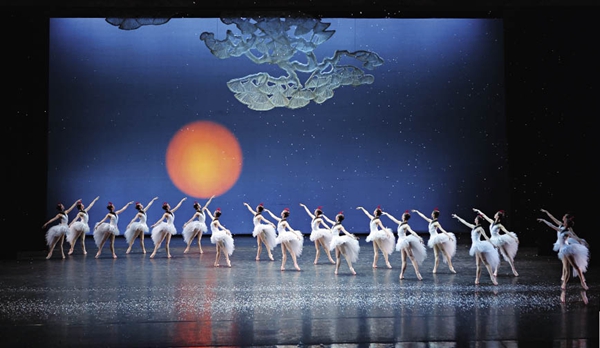
The corps de ballet in a scene from Celebrating Spring Festival.
“Rising from the West, ballet has yielded positive results in China. After six decades of ongoing effort, we have explored ways of our own,” Feng said.
At the initial stage, under the guidance of Soviet artists, such as celebrated ballet master Pyotr Gusev, the NBC rehearsed a series of classic ballet masterpieces such as Swan Lake and Giselle, laying a solid foundation for the Russian school of China’s ballet arts. After the start of reform and opening-up, the NBC not only absorbed various other schools from countries like the U.S., the U.K., France, Italy and Denmark, but also invited grandmasters worldwide through artistic exchanges. The troupe also has rehearsed a wider body of work, including Sleeping Beauty, Romeo and Juliet and Don Quixote.
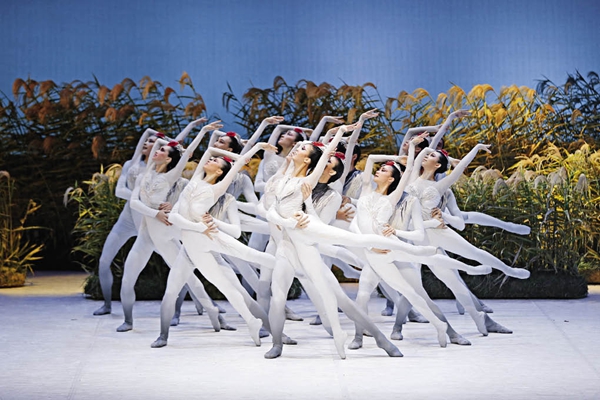
An evocative scene from Crane Whisperer.
“These productions help us to draw in the quintessential features of classical ballet globally, while ensuring our own style – maintaining the rigorous style of classical ballet,” Feng said. “At present, the NBC has become one of the top 10 ballet troupes worldwide. The high level of China’s classical ballet has been universally accepted by the world, and Chinese dancers are usually strong performers at world competitions, having not only accurately grasped the skills of classical ballet, but also imbuing it with their distinctive styles. To say the least, Chinese ballet troupes now have a voice in classical ballet.”
From Swan Lake to Red Detachment of Women
To learn from other’s strengths has remained the major path for the NBC to attain today’s success. In addition to upholding the precision of classical ballet, the NBC has also created fine works that reflect China’s national sentiments and indigenous culture.
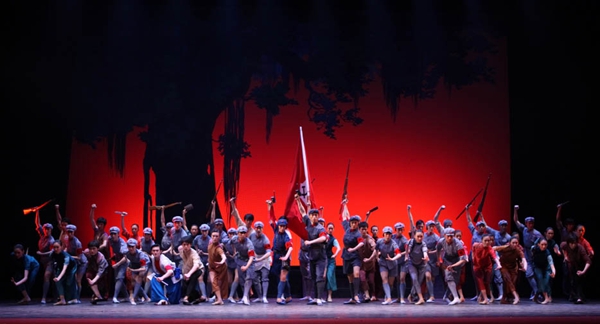
The Advance – a thrilling spectacle from The Red Detachment of Women.
The Red Detachment of Women, a ballet first launched in the 1960s, set a precedent in blending Eastern and Western cultures in China’s ballet history. Over the past five decades, this milestone classic has been performed over 4,000 times, both at home and abroad. Moreover, Albania’s National Corps de Ballet and Japan’s Matsuyama Ballet successfully performed this ballet as well, gaining it enormous international stature. In July 2015, this red classic was performed at the Lincoln Center in New York.
In response to the question of enabling a Western audience to understand works based on China’s revolutionary history, Feng answered that ballet possesses its own advantages – stemming from the West, making it an artistic form easily accepted by Western audiences, and even more importantly, finding commonality between Chinese and Western cultures.
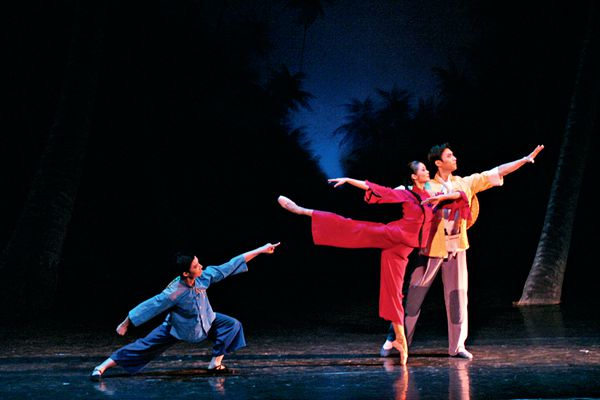
Guiding the Way to the Red Army Base – a scene from The Red Detachment of Women.
The Red Detachment of Women narrates the changing destiny of a woman, at first in unwitting revolt against her oppressive fate, who later voluntarily joins a revolutionary organization in pursuit of shared goals.
“Although the U.S. places more stress on individual heroism, situations often require others’ support to achieve a goal. The heroine Qionghua, unable to change her fate alone, joins with other people in the same boat to change their common destiny. This type of theme is recognized by people from different countries. Besides, emotional expression may be conveyed through body language,” Feng said. “Its success laid a foundation for China’s ballet performances, also enhancing our confidence in expressing national sentiments in our own way.”
These brilliant and distinctive works are the reason why the NBC can perform on a world stage. “To deliver human feelings through an accessible language of art has been NBC’s guiding idea over the years,” Feng said.
In recent years, the NBC has committed to creating works with Chinese style and characters, such as Lin Daiyu, adapted from Chinese classic masterpiece Dream of Red Mansions, New Year Sacrifice adapted from Lu Xun’s short story of the same title, as well as Crane Whisperer adapted from real events.
Ballet without Borders
In July 2015, led by Feng, the 180-member troupe toured the U.S., becoming the first Chinese national-level artistic performance group to be invited to the Lincoln Center Festival. From July 8 to 11, the NBC successfully performed a number of original works, including The Peony Pavilion, The Red Detachment of Women, and The Yellow River. At the end of every show, performers responded to calls for encores time and time again, fully demonstrating the appeal of Chinese ballet. Soon afterwards, the NBC gave performances in the states of New York and Virginia.
According to the director, The Peony Pavilion displays a Chinese artistic conception and romantic story for Western audiences. “Western aesthetics focuses on realism, while Chinese culture pursues a more subtle artistic ambience and sentiment,” Feng said. When they performed at a semi-outdoor theater in Wolf Trap National Park, the stage setting merged beautifully with the natural surroundings, helping spectators to immerse themselves in appreciation of Eastern aesthetics. In addition, this idealistic love story illustrated deeper meanings in Chinese culture.
The tour is listed as an achievement of the sixth annual U.S.-China High-level Consultation for People-to-People Exchange, and attracted the attention of U.S. cultural circles and mainstream media such as The New York Times and The Wall Street Journal.
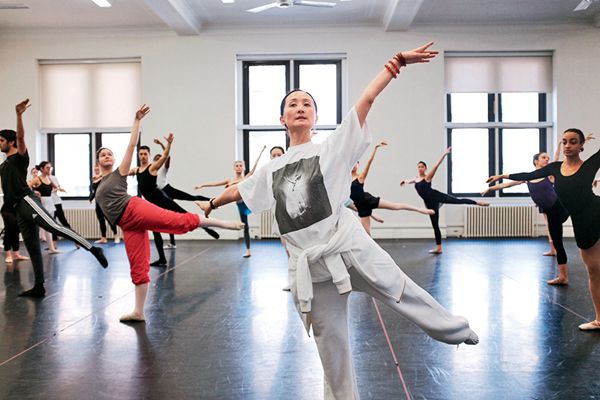
Feng Ying gives a ballet class at Columbia University.
Last February, Feng was invited to New York University (NYU) and Columbia University. Feng delivered a lecture on Ballet in China at NYU, which was well received by more than 200 teachers and students. She also gave classes at NYU and Columbia University. In addition, she held exhibitions and events at the China Institute to introduce Chinese culture and civilization via performance and speeches, enhancing mutual understanding between the two peoples.
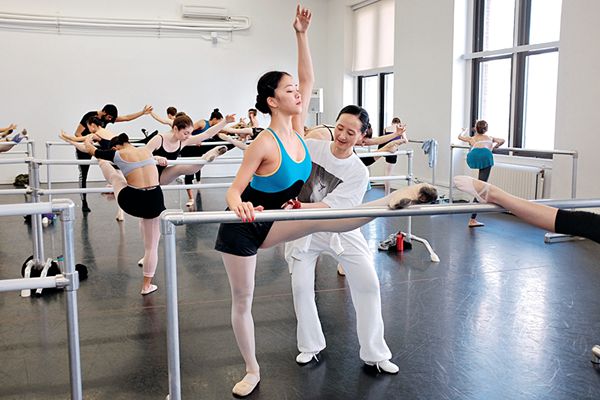
Feng Ying gives a ballet class at Columbia University.
“Ballet is an international language. Artists have nationalities, yet art has no borders. We adopt understandable and suitable ways to narrate Chinese stories and spread Chinese culture,” Feng said. Works like Celebrating the Spring Festival express happiness, reunion and harmony via the language of dance. The new program Crane Whisperer conveys harmony between people and nature. “Through these works, we wish to tell other peoples that, in terms of world outlooks and values, Chinese people and the people of other nations are interlinked. No matter in which country, these works are easily comprehended and appreciated by audiences.”
In Feng’s opinion, people in other countries generally have a limited understanding of China. “When I studied in France in the 1980s, the local people thought it unimaginable that people in China could dance ballet. When I visited the U.S. in recent years, I also felt that ordinary people know little about China,” Feng said. “But artistic works reflect a country’s spirit and temperament from all aspects. Therefore, we should have more arts groups and artistic forms traveling abroad. More people will then be able to understand our aesthetic and philosophical views and sentiments.”